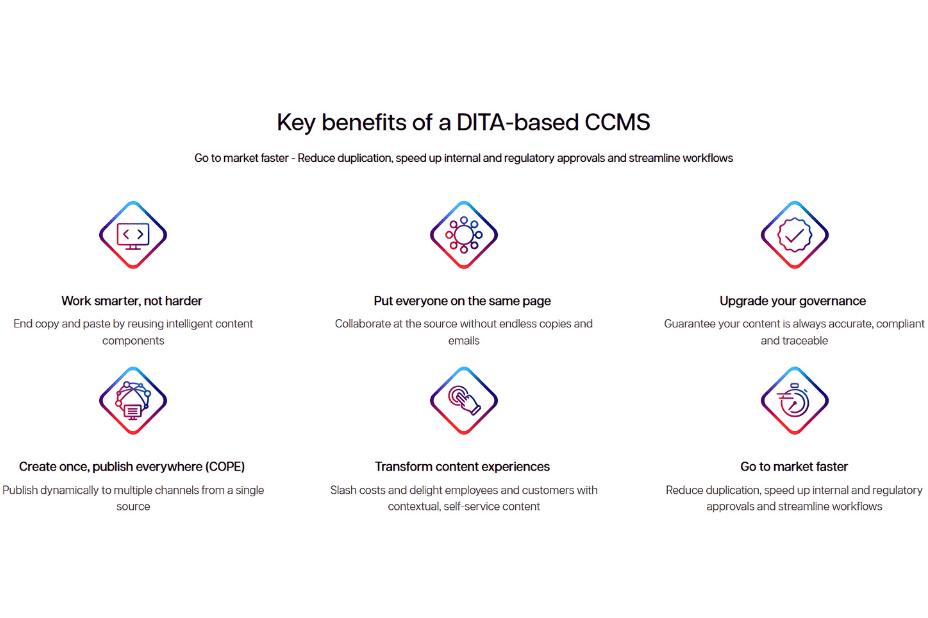Would you dare to do DITA without a CMS?
29 May 2025
 4 minutes
4 minutes

So your organization is ready to adopt Darwin Information Typing Architecture (DITA) – Great news!
But now it’s time to decide whether you dare to do DITA with, or without, a content management system (CMS) – While there’s no right or wrong answer, we’re here to provide you with the facts to make your decision easier.
Where did it all begin for DITA?
Not too long ago, we watched as many teams took baby-steps towards DITA—starting small, opting for standalone authoring tools, and only considering a CMS later in the game. The idea was to ease into it. But what often resulted was chaos: manual file management, low content reuse, poor version control, and little to no publishing customization. Deadlines got tighter, costs increased, and the ROI was poor.
But we’re seeing a shift – DITA has come of age, and for many is now seen as a critical business capability. As a result, organizations are committed to do DITA right from the get-go. With smart information architecture and change management procedures, a DITA-enabled CMS provides countless business benefits, from simplifying learning, to reducing associated content management challenges.
The many business benefits of DITA
Whatever you and your organization’s motivation for adopting DITA, the benefits of doing so speak for themselves:
- Competitive sales advantage – Documentation agility that matches agile product development for the addition of new product features and functionality.
- Customer support – Fewer product returns through always up-to-date content and product support.
- Information exchange – Easier content and information exchange with resellers and OEM partners for higher channel sales.
- Personalization – Product content tailored to customer profile to increase satisfaction and reduce call center costs.
- Time-to-market – Reduced time of delivery to global markets.
Coupled with reported efficiency gains of 30-50% (figure 1), up to 100% reduction in Desktop Publishing costs, up to 79% reduction in translation costs through translation reuse, if your organization is looking to increase productivity and speed up ROI, moving to DITA is an obvious choice.

(Figure 1)
But do I really need a specialized CMS?
To really answer this question, let’s look back to the early days of the internet.
Today we know that web presence and an efficient CMS go hand-in-hand … but it wasn’t always that way.
When the Internet was in its prime, Notepad and simple HTML editors were the webmaster’s tools of choice, and were ideal for the simplicity of first-generation websites.
But as the emphasis on Web-based customer experience, brand establishment, and sales grew, it was quickly realized that background coding alone wasn’t going to cut it. To keep up with the rapidly changing web landscape, a unifying and collaborative platform was vital.
Cue the specialization and rapid adoption of web content management systems (WCMS)!
Today, we see similar factors driving businesses to adopt specialized CMSs for DITA, often called “DITA-enabled” or “component content management systems” (CCMS). Collaborative working, streamlined workflows, and various forms of required output may all sound like familiar requirements to you and your organization.
As with the early days of the web, Many DITA-adopters today are asking; “Do I really need a CCMS?” – The evidence we’ve seen points towards “yes”.

DITA Challenges? Not with the right CMS!
While challenges can arise from implementing DITA, adopting a CMS designed specifically for the job will provide you with the tools you need to tackle these challenges. With the right CMS, you can:
- Create and deliver multi-channel content | Build modular DITA content and publish it across multiple channels, including help files, mobile apps, websites, manuals, and, nowadays, AI agents.
- Manage versions, workflows, and translations | Track content status, versions, and translation flows with built-in automation, approval, and auditing tools.
- Enable collaboration and quality control | Support team review, feedback, and editing in real time to maintain content accuracy and collaboration.
- Boost reuse and findability | Use metadata and search to find, reuse, and adapt topics efficiently—even across translations
- Monitor performance and prove value | Leverage reporting and analytics to improve processes, measure success, and demonstrate ROI to stakeholders.
So how do you get there?
Adopting this new methodology requires management support and buy-in. But as DITA continues to prove its successes with each deployment - efficiency gains, agility improvements and yearly translation savings to name just a few - management is coming to understand that topic-based writing is a must have.
As the demand for DITA grows as businesses expand and globalize, so too the need for a specialized DITA-enabled CMS is better understood. Organizations that adopt this methodology accelerate their time to DITA.
With Tridion Docs, our CCMS solution, you and your organization can fully harness DITA content for the creation, review, translation and delivery of global product information, creating a fully unified content strategy! So if you’re thinking about DITA, think about doing it right. Your future self (and your team) will thank you!
